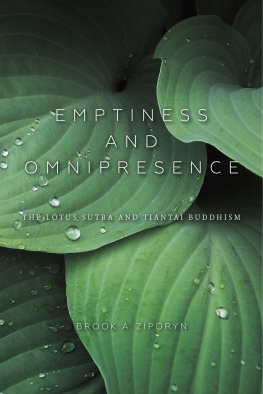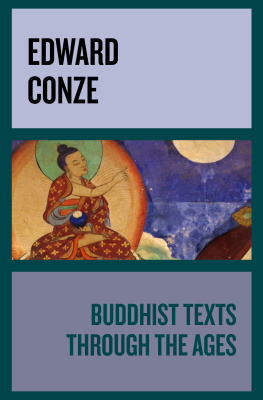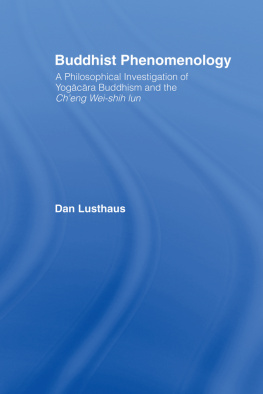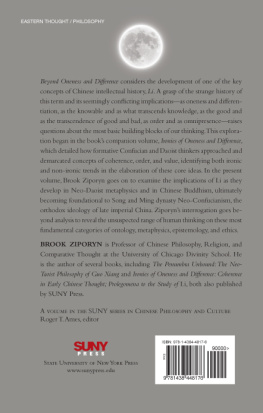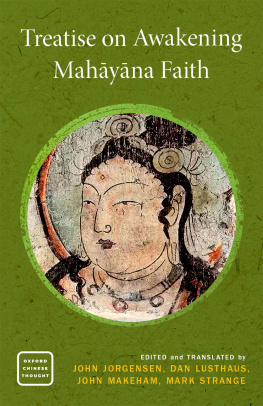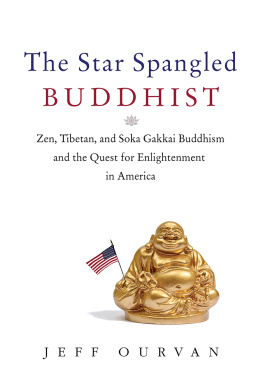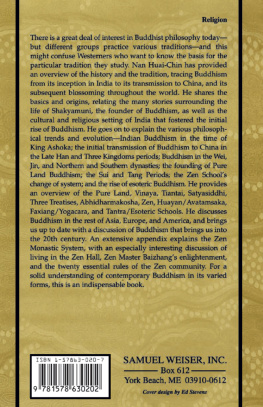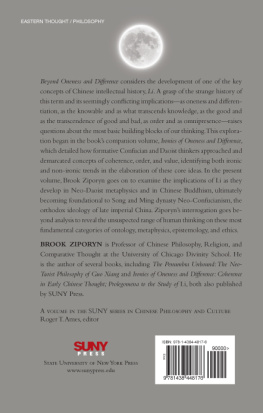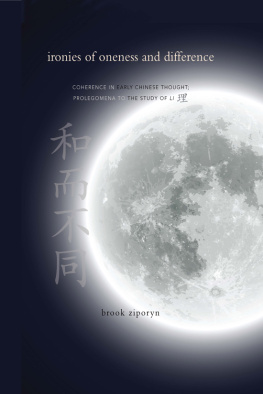
EMPTINESS
AND
OMNIPRESENCE
WORLD PHILOSOPHIES
Bret W. Davis, D. A. Masolo, and Alejandro Vallega, editors
EMPTINESS
AND
OMNIPRESENCE
AN ESSENTIAL INTRODUCTION TO TIANTAI BUDDHISM
BROOK A. ZIPORYN
INDIANA UNIVERSITY PRESS
Bloomington & Indianapolis
This book is a publication of
Indiana University Press
Office of Scholarly Publishing
Herman B Wells Library 350
1320 East 10th Street
Bloomington, Indiana 47405 USA
iupress.indiana.edu
2016 by Brook A. Ziporyn
All rights reserved
No part of this book may be reproduced or utilized in any form or by any means, electronic or mechanical, including photocopying and recording, or by any information storage and retrieval system, without permission in writing from the publisher. The Association of American University Presses Resolution on Permissions constitutes the only exception to this prohibition.
The paper used in this publication meets the minimum requirements of the American National Standard for Information SciencesPermanence of Paper for Printed Library Materials, ANSI Z39.481992.
Manufactured in the United States of America
Library of Congress Cataloging-in-Publication Data
Names: Ziporyn, Brook, [date] author.
Title: Emptiness and omnipresence : an essential introduction to Tiantai
Buddhism / Brook A. Ziporyn.
Description: Bloomington ; Indianapolis : Indiana University Press, [2016] |
Series: World philosophies | Includes bibliographical references and index.
Identifiers: LCCN 2015040149|
ISBN 9780253021083 (cl : alk. paper) |
ISBN 9780253021120 (pb : alk. paper) |
ISBN 9780253021205 (eb)
Subjects: LCSH: Tiantai Buddhism.
Classification: LCC BQ9118.5 .Z57 2016 |
DDC 294.3/92dc23 LC record available at http://LCCN.loc.gov/2015040149
1 2 3 4 5 21 20 19 18 17 16
To the monster of the sea: dragon palace at full fathom five and green thunderbolts of will and wave and endlessly reflecting gazing abyss, all of the above and all of the below.
CONTENTS
PREFACE
CONTEMPORARY PHILOSOPHICAL CONSCIOUSNESS FINDS ITSELF in a disorienting situation. The dissolution of monolithic conceptual hegemonies that has occurred in the wake of intensified intercultural communication presents a new set of challenges, calling for a way forward that both respects and creatively develops the unwieldy diversity of seemingly incommensurate cultural systems that are now beginning to come into contact with one another. These unprecedented challenges, however, also provide unprecedented opportunities. Traditional Chinese Buddhist thought can make a claim for particularly close philosophical attention in this cultural situation in that it preserves for us the record of perhaps one of the only commensurate premodern examples of an analogous philosophical predicament. Chinese Buddhism emerged from the world-historical encounter between two deeply disparate cultural and philosophical traditions: the indigenous traditions of India (and, more generally, Indo-European cultures) and East Asian cultures.
The earliest attempt at a thoroughgoing Sinitic reworking of the Indian Buddhist tradition is found in the Tiantai school, founded in the fifth century CE, which through supreme intellectual effort forged a vocabulary with which to bring these two worlds of thought into creative dialogue, developing a synthesis that simultaneously satisfies their very dissimilar demands, thereby producing an entirely new vision of Buddhism and indeed of the human condition. In its full flowering, Tiantai creates the most rigorous theoretical edifice in all of East Asian intellectual history, using modes of argumentation and praxis that are derived squarely from Indian Buddhism but in the service of ideals and metaphysical conclusions that are rooted deeply in the indigenous philosophical traditions. The result is a comprehensive system of thought that is utterly new, rarely understood, and, as it happens, still quite unique and unduplicated fifteen centuries later.
This book presents an interpretation of the ontology, metaphysics, epistemology, and ethics of Tiantai Buddhism, as rooted in that traditions reappropriation of general Buddhist philosophical concepts of suffering, conditionality, nonself, desire, emptiness, inherent enlightenment, and Buddha-nature, and of the way those doctrines are seen by Tiantai tradition to have been radically reconfigured by the narrative innovations of the Lotus Stra (full Sanskrit name: Saddharma Pudarka Stra). The distinctive ideas developed in this school of thought have not yet received attention commensurate to their potential philosophical importance in English-language scholarship. Some of my own past works have attempted to redress this underrepresentation, but have done so by pursuing a textual-based cultural-historical approach to Tiantai internecine doctrinal disputes (Evil and/or/as the Good: Omnicentrism, Intersubjectivity, and Value Paradox in Tiantai Buddhist Thought [Cambridge: Harvard University Press, 2000]) and an experimental exploration of potential further applications of Tiantai ideas (Being and Ambiguity: Philosophical Experiments with Tiantai Buddhism [Chicago: Open Court, 2004]). These two previous works seem to have presented some difficulty to many readers, largely due to their level of detail and specificity, their rather close mirroring of the not very user-friendly commentarial forms of argumentation found in classical Tiantai works in Chinese, and the faithful reproduction of the deliberately counterintuitive and sometimes byzantine doctrinal formulations found in those traditional texts. The present work, in contrast, is meant to present the key Tiantai ideas and their antecedents in more direct and less mediated terms, in a way that will be comprehensible to educated contemporary philosophical readers of all backgrounds. The work spells out the steps of the arguments behind the basic premises of Buddhist thought and how these both underpin and are undermined by the revolutionary Mahyna concepts of Emptiness, Two Truths, upya, bodhisattvahood, Buddha-nature, and inherent enlightenment. In language that is meant to be at once nontechnical and yet maximally lucid, dialectically rigorous and yet intuitively accessible, philosophically precise and yet implicatively expansive, the book is an attempt to reframe the distinctive insights of that tradition so as to bring out the radical resonances these ideas have for central issues of contemporary philosophical reflection and dialogue.
ACKNOWLEDGMENTS
MANY THANKS ARE DUE TO A LONG LIST OF PEOPLE WHO HAVE for one reason or another found themselves reading and commenting on various versions of this manuscript, in whole or in part, over the years: first of all to my students, who admittedly had no choice, but who consistently rose to the occasion, alerting me to crucial conceptual and rhetorical nodal points as much with their revelatory left-field perplexities as with their equally expansive left-turn applications; and also to devoted and attentive outside readers like Koichiro Yoshida, Priya Nelson, and Malcolm Pearce, and most recently my brother, Evan Ziporyn. Their responses and queries have brought immeasurably greater clarity and depth to both the contents and the presentation of the ideas of this work, both reining me in and goading me open. Thanks are also due to the Mellon Foundation for its generous support toward the completion of this project.
EMPTINESS
AND
OMNIPRESENCE
INTRODUCTION
THIS BOOK PRESENTS CERTAIN IDEAS ABOUT SUFFERING AND liberation from sufferingabout human well-beingdeveloped in a distinctive tradition of Chinese Buddhism known as the Tiantai school. In particular, I draw from the philosophical ideas developed from the sixth to eleventh centuries by this school as expounded in the writings of its three most representative figures: Tiantai Zhiyi (538597), Jingxi Zhanran (711782), and Siming Zhili (9601028). It should be noted at the outset that many people, even those who are used to the complexities of Buddhist thinking and its sometimes surprising paradoxes, tend to find Tiantai claims wildly perplexing, contradictory, even shocking. This is because the key ideas of Tiantai Buddhism seem at first to be wildly at odds not only with common sense but also with sanity, religion, ethical lifeindeed, even with the goals and orientations of Buddhism itself.
Next page
